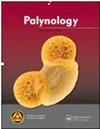墨西哥尤卡坦半岛南部不同干扰程度地区蜜蜂的植物学特征
IF 1.3
4区 地球科学
Q3 PALEONTOLOGY
引用次数: 0
摘要
摘要养蜂是墨西哥的一项重要经济活动,森林砍伐、粗放农业和其他类型的土地利用威胁着可持续的蜂蜜生产。本研究旨在确定金塔纳罗奥州尤卡坦半岛南部不同干扰程度的植被类型中,香蜂花用于蜂蜜生产的花资源。在该地区蜂蜜产量最高的几个月(2022年2月至5月),共从8个养蜂场采集了24个蜂蜜样本。采用标准的乙酰乙酸裂解技术进行花粉分析。共鉴定出68种花粉类型。我们的研究结果表明,植被的干扰程度不会影响花粉多样性和蜂蜜成分,主要是因为可用的花资源保持相似。在2月和3月的蜂蜜样品中,齿叶紫苏(Astraceae)是最丰富的草本物种(>45%)。3月样品中的豌豆心孢子虫(蚕豆科)和campechianum血霉菌(蚕豆科的)(16%-45%),4月样品中豌豆心孢子菌(>45%)。Spondias mombin(Anacardiaceae)、Bursera simaruba(Burseraceae)和Met鸦片布朗尼(Anacardicaceae)是5月份样本中发现的最丰富的树栖物种(16%-45%)。尽管我们的研究结果可以用于制定寻求可持续蜂蜜生产的保护策略,但进一步的研究应该集中在更长时间内具有更好保护状态的植被上,以及在可供蜜蜂使用的资源较少的时期。本文章由计算机程序翻译,如有差异,请以英文原文为准。
Botanical characterization of Apis mellifera honeys in areas under different degrees of disturbance in the southern Yucatan Peninsula, Mexico
Abstract Apiculture is an important economic activity in Mexico, and deforestation, extensive agriculture, and other types of land use threaten sustainable honey production. This study aimed to determine the floral resources used by Apis mellifera for honey production, in vegetation types with different disturbance degrees in Southern Yucatan Peninsula, Quintana Roo state. A total of 24 honey samples, from eight apiaries, were collected during the months of the highest honey production in the region (February to May 2022). Standard acetolysis technique was applied for melissopalynological analysis. A total of 68 pollen types were identified. Our results suggest that the disturbance degree of the vegetation does not affect the pollen diversity and honey composition, mainly because the available floral resources remain similar. Viguiera dentata (Asteraceae) was the most abundant (>45%) herbaceous species in honey samples of February and March. Piscidia piscipula (Fabaceae) and Haematoxylum campechianum (Fabaceae) in samples of March (16%-45%), and P. piscipula in April (>45%). Spondias mombin (Anacardiaceae), Bursera simaruba (Burseraceae), and Metopium brownie (Anacardiaceae) were the most abundant (16%-45%) arboreal species found in samples of May. Although our results can be used to develop conservation strategies looking for sustainable honey production, further studies should focus on vegetation with a better conservation state, during longer time periods, and during periods with fewer resources available for honeybees.
求助全文
通过发布文献求助,成功后即可免费获取论文全文。
去求助
来源期刊

Palynology
地学-古生物学
CiteScore
3.40
自引率
26.70%
发文量
48
审稿时长
>12 weeks
期刊介绍:
Palynology is an international journal, and covers all aspects of the science. We accept papers on both pre-Quaternary and Quaternary palynology and palaeobotany. Contributions on novel uses of palynology, review articles, book reviews, taxonomic studies and papers on methodology are all actively encouraged.
 求助内容:
求助内容: 应助结果提醒方式:
应助结果提醒方式:


